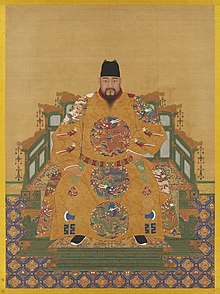| Emperor Yingzong of Ming 明英宗 | |||||||||||||||||
|---|---|---|---|---|---|---|---|---|---|---|---|---|---|---|---|---|---|
 | |||||||||||||||||
| Emperor of the Ming dynasty | |||||||||||||||||
| First reign | 31 January 1435 – 22 September 1449 | ||||||||||||||||
| Enthronement | 7 February 1435 | ||||||||||||||||
| Predecessor | Xuande Emperor | ||||||||||||||||
| Successor | Jingtai Emperor | ||||||||||||||||
| Regents | See list
| ||||||||||||||||
| Second reign | 11 February 1457 – 23 February 1464 | ||||||||||||||||
| Predecessor | Jingtai Emperor | ||||||||||||||||
| Successor | Chenghua Emperor | ||||||||||||||||
| Emperor Emeritus of the Ming dynasty | |||||||||||||||||
| Tenure | 22 September 1449 – 11 February 1457 | ||||||||||||||||
| Crown Prince of the Ming dynasty | |||||||||||||||||
| Tenure | 1428–1435 | ||||||||||||||||
| Predecessor | Crown Prince Zhu Zhanji | ||||||||||||||||
| Successor | Crown Prince Zhu Jianshen | ||||||||||||||||
| Born | 29 November 1427 | ||||||||||||||||
| Died | 23 February 1464 (aged 36) | ||||||||||||||||
| Burial | Yu Mausoleum, Ming tombs, Beijing | ||||||||||||||||
| Consorts | |||||||||||||||||
| Issue Detail | |||||||||||||||||
| |||||||||||||||||
| House | Zhu | ||||||||||||||||
| Dynasty | Ming | ||||||||||||||||
| Father | Xuande Emperor | ||||||||||||||||
| Mother | Empress Xiaogongzhang | ||||||||||||||||
| Chinese name | |||||||||||||||||
| Chinese | 明英宗 | ||||||||||||||||
| |||||||||||||||||
| Zhengtong Emperor | |||||||||||||||||
| Traditional Chinese | 正統帝 | ||||||||||||||||
| Simplified Chinese | 正统帝 | ||||||||||||||||
| |||||||||||||||||
| Tianshun Emperor | |||||||||||||||||
| Traditional Chinese | 天順帝 | ||||||||||||||||
| Simplified Chinese | 天顺帝 | ||||||||||||||||
| |||||||||||||||||
Emperor Yingzong of Ming (29 November 1427 – 23 February 1464), personal name Zhu Qizhen, was the sixth and eighth emperor of the Ming dynasty. He ruled as the Zhengtong Emperor from 1435 to 1449, and as the Tianshun Emperor from 1457 until his death in 1464.
He was the eldest son and successor of the Xuande Emperor. After ascending the throne, he adopted the era name Zhengtong, which means "right governance". During his first reign, the empire was at its height of prosperity and power. As the first child emperor of the Ming dynasty, Emperor Yingzong's rule was heavily influenced by high dignitaries at court. Initially, his grandmother, Grand Empress Dowager Zhang, along with the "Three Yangs" (Yang Shiqi, Yang Rong, and Yang Pu), held the highest positions of power. However, in 1442, the emperor began to listen more to the eunuch Wang Zhen.
In 1449, at Wang Zhen's suggestion, Emperor Yingzong personally led the army against the Mongol army of Esen Taishi. Unfortunately, at the Battle of Tumu Fortress, the Ming army was defeated and the emperor was captured. This event shocked the government and the country, leading the court to elevate Yingzong's brother, Zhu Qiyu, to the throne as the Jingtai Emperor. During his captivity, Emperor Yingzong had established good relations with Esen and was eventually released in 1450.
After Emperor Yingzong returned to his homeland, his brother felt threatened and ordered him to stay in the Southern Palace within the Forbidden City. He also restricted Emperor Yingzong's contact with the outside world. Essentially, Emperor Yingzong was placed under house arrest. In early 1457, the Jingtai Emperor fell ill and, since his only son had died in 1453, there was no heir to the throne. Taking advantage of this opportunity, Emperor Yingzong organized a palace coup and regained power in February 1457. The era name of his second reign was Tianshun, which means "obedience to Heaven". The following month, the Jingtai Emperor died.
Emperor Yingzong ruled for another seven years before his death in 1464 at the age of thirty-six. His eldest son, the Chenghua Emperor, then ascended to the imperial throne.